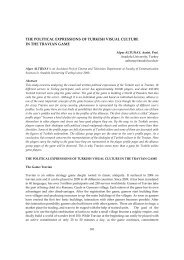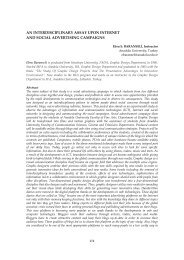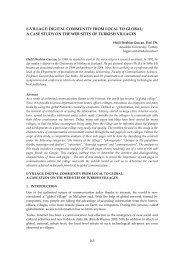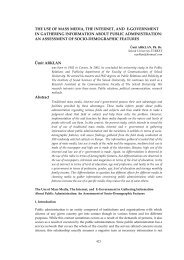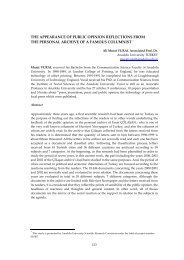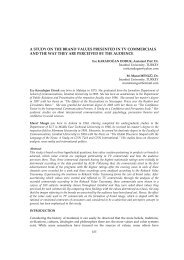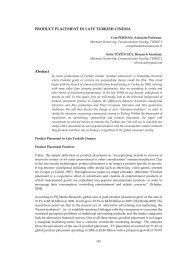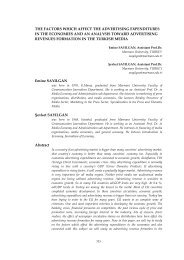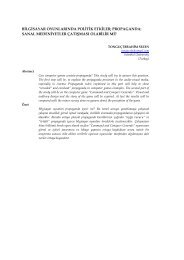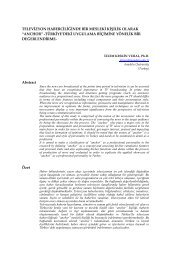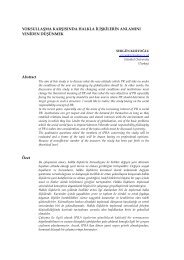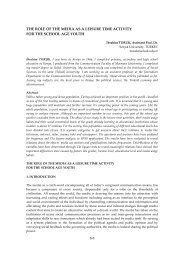the evaluation of turkish consumers' attitudes towards foreign products
the evaluation of turkish consumers' attitudes towards foreign products
the evaluation of turkish consumers' attitudes towards foreign products
Create successful ePaper yourself
Turn your PDF publications into a flip-book with our unique Google optimized e-Paper software.
8. Is <strong>the</strong>re any relation between <strong>the</strong> <strong>attitudes</strong> <strong>of</strong> Turkish consumers <strong>towards</strong> <strong>the</strong><br />
<strong>products</strong> made in Germany, Italy and France, <strong>the</strong> <strong>attitudes</strong> <strong>towards</strong> <strong>the</strong> marketing<br />
activities <strong>of</strong> <strong>the</strong>se <strong>products</strong> and <strong>the</strong> <strong>attitudes</strong> <strong>towards</strong> <strong>the</strong> importance <strong>of</strong> country<br />
origin?<br />
Limitations<br />
The limitations, which may affect <strong>the</strong> generalization <strong>of</strong> <strong>the</strong> research findings, can be<br />
stated as follows:<br />
1. The study is limited to only three countries, Germany, Italy and France. These three<br />
countries have been chosen depending on <strong>the</strong> data <strong>of</strong> <strong>the</strong> external trading duties<br />
undersecretary. In <strong>the</strong> categories chosen depending on <strong>the</strong> data <strong>of</strong> <strong>the</strong> year, 2003<br />
(o<strong>the</strong>r foodstuffs; drinks, tobacco and its <strong>products</strong>; <strong>products</strong> <strong>of</strong> automotive<br />
industry; <strong>of</strong>fice machines and communication systems; o<strong>the</strong>r machines and<br />
transportation means; <strong>the</strong> <strong>products</strong> <strong>of</strong> textile industry; ready –made clothing; o<strong>the</strong>r<br />
consumption properties), Germany, Italy and France are <strong>the</strong> countries which<br />
imported <strong>the</strong> most <strong>products</strong>. The choice <strong>of</strong> product categories has been done<br />
considering <strong>the</strong> latest <strong>products</strong> reaching consumers.<br />
2. The participants <strong>of</strong> <strong>the</strong> study consist <strong>of</strong> <strong>the</strong> students from Communication Sciences<br />
Faculty at Anadolu University<br />
METHOD<br />
The descriptive method, in which an already existing case is studied, is used in <strong>the</strong> study<br />
with <strong>the</strong> use <strong>of</strong> questionnaire, observation and interviews.<br />
The participants have been chosen as <strong>the</strong> 2003-2004 fall –term students at communication<br />
Sciences faculty at Anadolu University. To choose <strong>the</strong> participants <strong>of</strong> <strong>the</strong> study, all <strong>the</strong><br />
teaching schedules are taken and all <strong>the</strong> courses having more than 30 attending students<br />
are listed. Using this list, participants are chosen randomly. The questionnaire is applied<br />
to 178 students in total as 94 male and 84 female.<br />
Data and Data Collection<br />
Attitude scale for country <strong>products</strong>, <strong>the</strong> marketing activities <strong>of</strong> <strong>the</strong>se <strong>products</strong> and <strong>the</strong> importance<br />
<strong>of</strong> country origin: <strong>the</strong> attitude scale developed by darling and Puetz and consisting <strong>of</strong> 31<br />
items, is used in <strong>the</strong> study. In <strong>the</strong> scale, five –likert- scale is used. (1= strongly agree, 2=<br />
agree, 3= no idea, 4= disagree, 5= strongly disagree). The scale consists <strong>of</strong> <strong>the</strong>e main parts.<br />
The items numbered between 1 and 13 aim to measure <strong>the</strong> consumers’ <strong>attitudes</strong> <strong>towards</strong><br />
<strong>the</strong> marketing activities <strong>of</strong> <strong>the</strong> <strong>products</strong> <strong>of</strong> <strong>the</strong> chosen countries. The items numbered<br />
between 14 and 26 aim to measure <strong>the</strong> <strong>attitudes</strong> <strong>of</strong> <strong>the</strong> <strong>products</strong> <strong>of</strong> <strong>the</strong> chosen countries<br />
<strong>towards</strong> <strong>the</strong> marketing activities. The items 14 and 15 are about services, 16 and 17 are<br />
about packaging, 18 and 19 are about pricing, 20 is about <strong>the</strong> name <strong>of</strong> trademark, 21 and<br />
22 are about outlets, 23 is about <strong>the</strong> locations <strong>of</strong> <strong>the</strong> outlets, 24, 25 and 26 are about<br />
advertising and promotions. The items numbered between 27 and 31 aim to measure <strong>the</strong><br />
importance <strong>of</strong> <strong>the</strong> knowledge <strong>of</strong> country origin.<br />
379



